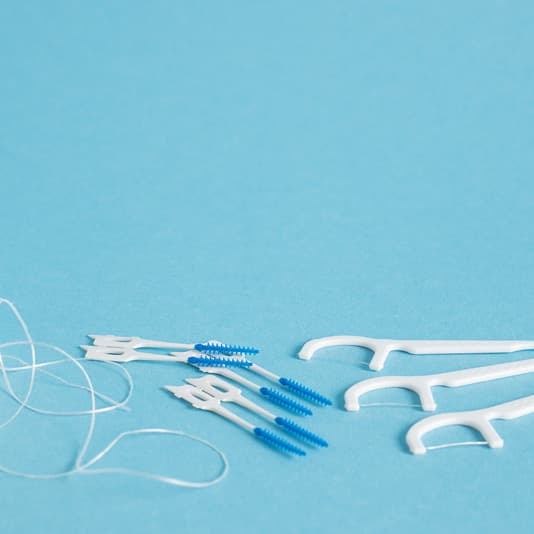A dentist's guide to brushing
Article published on 22/10/21 and clinically reviewed on 29/02/24
If someone asks how you look after your teeth, the first answer will be by brushing them, right? We all brush our teeth. The advice from dentists is to do it twice a day, morning and last thing at night, for two minutes at a time.
But how effective is your technique? Are you using the right toothpaste? Should you brush before or after food? Did you know the angle of how you use your toothbrush can make a difference?
There are so many questions for such a rudimentary task. But don't worry, we've got the answers to those questions, as well as answers to the questions you didn't even know you should be asking.
We sat down with dentist and Clinical Director at Simplyhealth and Denplan, Dr Catherine Rutland to create this handy guide to brushing your teeth the professional way.
First up, we need the right tools for the job.

What should you look for in a toothbrush?
Evidence suggests oscillating/rotating electric toothbrushes are recommended over manual ones1 because they offer better plaque removal and more significant reduction in gum problems like gingivitis (inflammation of the gums). Both types of toothbrushes can clean effectively, though, as long as you ensure that you're cleaning all of your teeth, all the tooth's surface areas, and brushing twice a day for two minutes.
Take a look at our helpful brushing guides below to ensure that you've got the proper technique. It can really make a difference. Dental professionals recommend changing your toothbrush or brush head every 90 days or sooner if you brush more than twice daily or longer than 2 minutes.2
Step-by-step guides to brushing your teeth properly
The right way to brush depends on what type of toothbrush you’re using. We've got a step-by-step process for both manual and electric, so your teeth will be covered.
How to brush your teeth with a manual toothbrush
Step 1
Place the head of your toothbrush against your teeth, then tilt the bristle tips at a 45-degree angle towards the gum line. Move the brush in small circular movements, several times, on all the surfaces of every tooth.
Step 2
Brush the outer surfaces of each tooth, upper and lower, keeping the bristles angled against the gum line.
Step 3
Use the same method on the inside surfaces of all your teeth.
Step 4
Brush the biting surfaces of the teeth.
Step 5
To clean the inside surfaces of the front teeth, tilt the brush vertically and brush with small circular strokes.
Step 6
Brushing your tongue will help freshen your breath and clean your mouth by removing bacteria.
How to brush your teeth with an electric toothbrush
Step 1
Hold the toothbrush horizontally, with the bristles against the side of your teeth.
Step 2
Guide the head of the brush slowly across each tooth, following the curve of your teeth and gums. Do not scrub or press hard, an electric toothbrush does the brushing for you with its rotating/oscillating head.
Step 3
Hold the brush head in each place for a few seconds and then move on to the next tooth.
Step 4
Remember to reach all areas of your teeth; insides, outsides, the chewing surface and behind your back teeth.
How much fluoride should be in my toothpaste?
No matter what age you are, I would always recommend using fluoride toothpaste. Fluoride helps prevent tooth decay and gum disease and combats bad breath, but you need to check the concentration in the toothpaste that you use. Fluoride is measured in parts per million (ppm), and the amount of fluoride required is different for children and adults, shown below. You can easily view the ppm on the toothpaste packaging, so it's worth checking next time you're shopping.
An extra piece of advice, always spit but never rinse as we want the fluoride to stay on your teeth for longer.
The ppm of fluoride required based on age:
All children up to 3 years only need a smear of toothpaste with a fluoride level of no less than 1000ppm.
Children aged 3-6 only need a pea-sized amount of fluoride toothpaste containing no less than 1000ppm.
Children aged 7 years to late teens should use fluoride toothpaste with 1350-1500 ppm.
Adults should use toothpaste with no less than 1350 ppm.
Should I brush my teeth before or after breakfast?
This is a question that is often asked, but unfortunately, there is no scientific proof of when is best to brush in the morning. However, I always recommend brushing your teeth after breakfast. This is because meals leave a lot of food debris on tooth surfaces and if this is not removed by brushing it can remain there for many hours.
If breakfast includes acidic food or drinks e.g. orange juice, it's recommended to delay brushing for at least 30-60 minutes to reduce the risk of erosive tooth wear.

What does mouthwash do?
There are different types of mouthwash. Some may help to keep your breath fresh, a fluoride rinse may provide an anti-cavity benefit, and some have germ-fighting ingredients to reduce plaque build-up.
Remember that mouthwash is not an alternative to brushing your teeth, and you need to follow the instructions on the bottle to ensure you are swishing for long enough!

Why do my gums bleed when I brush my teeth?
This is most commonly due to inflammation of the gums (gingivitis) but can occasionally be due to brushing too vigorously.
Gingivitis is an early stage of gum disease caused by bacteria in plaque irritating your gums, making them red and puffy.
The best way to help bleeding gums is to make sure that you're keeping your teeth as clean as possible. It is also important to visit your dentist for regular check-ups for prevention advice and to detect any early problems with teeth and gums, which can be easily be reversed. My advice would be to brush twice daily and use interdental brushes or floss regularly.
Prevention is the key to a healthy mouth.
What do interdental brushes and dental floss do? And should I use them? Should I clean between my teeth?
If you look at your teeth, quite a lot of their surface area is against other teeth or in hard-to-reach places. This is where interdental brushes and floss are useful in reaching areas of the mouth that our toothbrushes can't. Gaps between teeth can make it easy for food to get stuck and plaque to build up, potentially leading to gum disease.
When it comes to choosing interdental brushes, floss or both, it's a personal preference. However, one thing to note is that interdental brushes come in different sizes to fit perfectly into any sized gap and have handles that help you reach the tricky areas at the back of your mouth.

This material may contain links to other websites operated by third parties. It is the responsibility of third parties to ensure such material and websites comply with all relevant laws and regulations. To the maximum extent permissible by law Simplyhealth disclaims all responsibility for such websites.